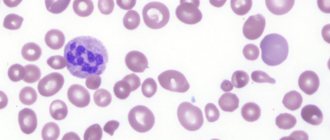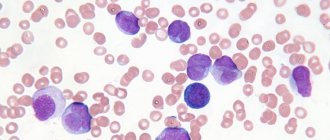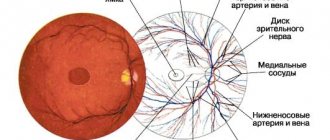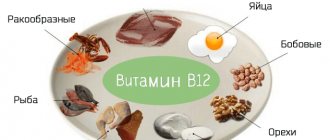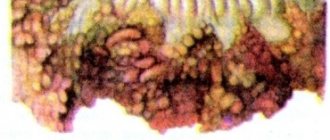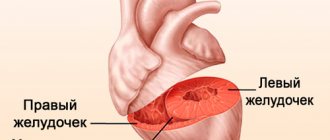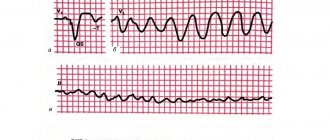Sickle cell anemia is a chronic blood disease that is associated with a structural disorder of hemoglobin proteins. When studying biological material under a microscope, it seems that they consist of many small crystals.
In hematology, the disease is also called by the medical term hemoglobinopathy. The disease has a hereditary etiology and is transmitted to children along with genetic information from the mother or father.
Patients with sickle cell anemia also have an unusual shape of blood cells called red blood cells, which serve the function of transporting hemoglobin. They have the shape of a crescent or sickle, which is why the disease received its name.
The occurrence of sickle cell anemia is associated with mutational processes in the HBV gene. As a result of this pathology, abnormal hemoglobin S begins to be synthesized in the human body, and class A protein must be produced, which fully performs the function of delivering oxygen molecules.
Under the influence of unfavorable factors present in the environment, or associated with stress loads on the body of the carrier of the mutated gene, polymerization of class S hemoglobin occurs.
This protein compound forms elongated strands, as a result of which blood cells form elongated sickle-shaped cells. Inheritance of sickle cell anemia occurs in an autosomal recessive manner, but without complete dominance of the gene that has undergone mutational changes.
Stages and degrees
Sickle cell anemia can be completely asymptomatic, without disturbing the carrier of the mutated gene, or it can manifest itself in the form of chronic hypoxia, a feeling of lack of oxygen from the first days of a person’s life. The severity of the current disease depends on the degree of mutation of the HBV gene, as well as the amount of genetic information received from the parents.
The table below lists the severity of sickle cell disease:
| Severity | Clinical picture of the disease |
| First | The patient does not experience pathological symptoms of insufficiency in the functioning of altered red blood cells and abnormal hemoglobin S. The disease manifests itself only periodically during sports, performing heavy physical activity associated with lifting loads, active movement. |
| Second | A person with sickle cell anemia experiences chronic fatigue and loss of physical strength. His independent movement at a distance of more than 200 m is impossible due to the fact that a feeling of fatigue and lack of air quickly arises. To restore normal supply to the tissue cells of internal organs, muscle fibers and the brain, long rest and recovery are required. |
| Third | Chronic fatigue syndrome and constant anemia are accompanied by soft tissue swelling. The patient suffers from chronic inflammation of the joints of the upper and lower extremities, which have signs of autoimmune arthritis. There is an increased tendency to colds and infectious diseases, which most often affect the patient’s body in the autumn and spring seasons. |
| Fourth | The most severe form and degree of sickle cell anemia. The patient develops radical changes in the biochemical composition of the blood. Multiple thromboses occur in the blood vessels of internal organs. Their functional ability decreases. Multiple internal hemorrhages and tissue damage appear. In most cases, the patient suffers from severe hypoxia, constantly lacks air and is bedridden. |
Formation of sickle cell anemia
Sickle cell anemia of grade 3 or 4 can lead to disability and even cause death.
This disease of grades 1 and 2 gives a relatively favorable prognosis for maintaining an optimal quality of life, but only on the condition that the human body is not subjected to heavy physical stress.
Inheritance.
Also on topic:
erythrocytes
Research has shown that a mild form of the disease is usually found in heterozygotes for this trait - in other words, in those who have inherited the defective gene from only one parent and will pass it on to only half of their possible offspring. These individuals have the so-called heterozygous sickle cell anemia (S–A, or A–S). Although they themselves are practically not sick and may never get sick, they are still carriers of the disease, and - until special testing is carried out - hidden carriers.
The most severe form of the disease affects homozygotes for the defective gene, i.e. who inherited it from both mother and father; they will pass this gene on to all their descendants. Their condition is called homozygous sickle cell disease (S-S).
Also on topic:
ANEMIA
The intermediate form of the disease usually occurs in double heterozygotes, i.e. persons heterozygous for both this and any other hemoglobinopathies (for example, they synthesize hemoglobin C). In such cases they talk about S-C disease or some similar conditions.
Symptoms
Signs of sickle cell anemia are manifested by two main types of pathological conditions of the body. In the first case, the symptoms of the disease can manifest exclusively as oxygen starvation, shortness of breath and fatigue, which indicates a decrease in the transport function of hematological cells - red blood cells.
The second type of manifestation of the disease is associated with the destruction of red blood cells due to their increased fragility. In this case, multiple thromboses and hemorrhages occur in the tissues of the internal organs.
The most experienced hematologists, who are professionals in the diagnosis and treatment of sickle cell anemia, cannot describe the standard set of symptoms present in a patient with this disease. The disease is characterized by a wide range of signs of changes in the biochemical composition of the blood, as well as general dysfunction of internal organs and body systems.
The table below details all the symptoms of sickle cell anemia that were encountered in hematological practice, as well as their clinical manifestations.
| Symptom name | Characteristic features of manifestation |
| Anemia | In patients with sickle cell anemia, the hemoglobin level is reduced by 5-10 units. During the period of hemolytic crises, when the concentration of blood cells drops to critical levels, an increase in body temperature occurs (up to 38-39 degrees Celsius), the color of the urine changes from natural yellow to rich brown or completely black. To eliminate signs of anemia, the patient takes medications that replenish iron deficiency. |
| Attacks of severe pain in muscles and bone tissue | Changes in the biochemical composition of the blood and the structure of the protein compounds of hemoglobin lead to attacks of aching pain and aches in the body. This symptom most strongly affects the muscle fibers and bones of the lower extremities. The affected area contains bone and connective tissue of the joints. |
| Bacterial, viral and fungal infections | Due to changes in the qualitative composition of the blood, a drop in hemoglobin levels and a general weakening of the body, the protective function of the immune system decreases. The patient becomes susceptible to frequent bacterial, viral and fungal invasions. Even after slight hypothermia of the body, symptoms of a cold appear, body temperature rises, and local inflammatory processes develop in the larynx, upper and lower respiratory tract. It is possible for a bacterial infection to become chronic. |
| Formation of blood clots in the liver and spleen tissues | Red blood cells, which have an irregular structural shape, are, in addition, characterized by increased fragility. Blood cells are damaged in the narrow vascular ducts of the liver and spleen, accumulate in blood clots and form dense blood clots. After this symptom occurs, the functioning of all organs of the gastrointestinal tract is immediately disrupted. Dysfunction of liver tissue leads to yellowness of the skin, lack of appetite and the full functioning of the digestive system. |
| Heart and lung injuries | As the lungs and heart muscles work, the risk of blockage of their capillaries increases. If this happens, then local hemorrhages form in the tissues where the sickle-shaped red cells are damaged. In case of infection with bacterial microorganisms, a focus of chronic infection may occur in the tissues of these organs. Such injuries can cause death, pulmonary or heart failure. |
| The appearance of ulcerative formations on the lower extremities | Damage to irregularly shaped red blood cells leads to the formation of blood clots in the lower extremities. This leads to disruption of local blood circulation in the legs. Severe venous insufficiency develops. This pathological condition of the great vessels causes damage to their walls, loss of lymph and the formation of trophic ulcers. Wounds of this type do not heal well even if the patient receives special drug treatment. Trophic ulcers tend to increase in size and cover deeper tissues of the lower extremities. |
| Necrosis associated with the rapid development of sepsis | Tissues and blood vessels that have been damaged by sickle red blood cells, thrombotic, and deprived of nutrition begin to gradually die. The necrosis phase begins, which quickly moves into the stage of severe intoxication of the body and blood poisoning. This symptom can develop within 1-3 days from the formation of multiple blood clots or massive damage to the capillaries of the tissues of internal organs. The presence of this symptom of sickle cell anemia indicates an unfavorable prognosis for recovery and a high probability of death. |
| Violations in the functioning of the organ of vision | With sickle cell anemia, there is a disruption in the blood supply to the retina, as well as other elements of the eyeball. The formation of blood clots and organ damage can lead to a partial decrease in visual acuity, or cause complete blindness. |
| Anomalies of physical development | People who have inherited sickle cell anemia from their blood relatives do not immediately notice signs of the disease. Newborn children up to 3 months. can develop without obvious pathological abnormalities. Then, curvature of the bones of the upper and lower extremities and spine may occur. Deformation of the skull and jaw apparatus cannot be ruled out. Throughout the rest of their lives, patients with sickle cell anemia lag behind in physical development. Teenagers begin puberty late. On average, the lag is within 3 years. |
Depending on what other mutated genes that disrupt the functioning of the hematopoietic system the patient has inherited, other equally dangerous symptoms may occur. All of the above signs of the disease are determined by the attending physician in the inpatient department of the hospital.
Reasons for appearance
Sickle cell anemia is a genetic disease that is hereditary in origin. It can occur in conditions of 1st and 2nd degree of severity without transition to the stage of hemolytic crisis, or without the manifestation of other more severe symptoms.
The appearance of more extensive signs of the disease can be caused by the following causative factors:
- hard physical labor;
- sports activities;
- alcohol abuse, smoking, drug use
- climbing to a height of more than 1500 m, where there is a lack of oxygen;
- dehydration of the body;
- prolonged exposure to direct sunlight;
- conflict situations and psycho-emotional stress.
Any stress factor can serve as an impetus for exacerbation of the disease, the occurrence of a hemolytic crisis with damage to internal organs, the formation of blood clots and prolonged dysfunction of body systems.
Diagnostics
Sickle cell anemia is a dangerous pathology of the blood and hematopoietic system, which requires a comprehensive diagnosis of the whole organism.
A patient who has signs of this disease must undergo the following types of examination:
- initial examination by a doctor who listens to current complaints and symptoms, palpates the abdominal cavity, chest bones and limbs, and makes a referral for instrumental and laboratory diagnostics;
- donation of venous blood for its biochemical analysis;
- collection of capillary blood for clinical research and isolation of red blood cells;
- providing morning urine to determine the patient’s general health;
- ECG to ensure the stability of the heart muscle;
- blood pressure measurement;
- MRI of the whole body to evaluate the health of blood vessels, as well as tissue in internal organs that may have been damaged by blood clots and increased fragility of red blood cells.
Based on the results of a diagnostic examination, the attending physician confirms the presence of sickle cell anemia, or refutes the pathological condition of the blood and hematopoietic system. In public hospitals, examinations are carried out free of charge. In a medical institution with private ownership, the average cost of this diagnosis will be from 4,000 to 6,000 rubles.
Forecast
It is impossible to prevent a child from inheriting the form of anemia in question, which is inherited from parents. If there are such problems, expectant parents should consult a doctor even at the stage of planning pregnancy and understand all the risks.
Patients with this form of anemia rarely live more than 45-48 years. Most patients with severe forms die in childhood. Infectious or thrombotic problems usually lead to death.
However, even knowing such disappointing forecasts, patients should not give up. Try to do everything possible to maintain your well-being and level of health at a satisfactory level. To avoid acute crises, it is enough for the patient to protect himself from provoking factors and promptly treat concomitant pathologies.
When to see a doctor
Contacting a specialized specialist should take place within the first 1-2 days after a person discovers symptoms of sickle cell anemia. This disease is treated by a hematologist.
If the clinic does not have a doctor of this profile, then you need to make an appointment with a therapist. Delay in visiting a doctor is fraught with the development of a large number of complications associated with the functioning of the cardiovascular, digestive, immune and respiratory systems.
Genetics
The mode of inheritance of sickle cell anemia is recessive. You can consider it using the example: “AA+Aa=Aa/AA”. Here the anemia gene is a, that is, recessive, which will manifest itself fully only in the presence of a second similar gene. However, in the presented example, a completely healthy parent and carrier of the disease gives birth to a child with incomplete possession of the harmful gene. This is a case of heterozygous disease. You can find out more about it in the section below.
With a recessive type of inheritance, the risk of transmitting the disease is not one hundred percent. It can be transmitted in the following cases.
- Both parents are owners of the aa genes (100% probability).
- One of the parents is a carrier of the aa genes, the other is Aa (the probability of a heterozygous form is 100%, homozygous is 75%).
- Both parents are carriers of the Aa genes (the probability of a heterozygous form is 50%, a homozygous form is 25%, and the birth of a healthy child is 25%).
- One of the parents has the genotype AA, the other Aa (the homozygous form is impossible, the probability of heterozygous is 25%).
These data are used to predict the transmission of sickle cell anemia from parents to children when planning pregnancy. The only way to reduce the risk of the disease is to find another partner who is not a carrier of the gene.
Read also Polycythemia vera. Causes, treatment, prognosis
Heterozygotes
Inheritance of sickle cell anemia can be heterozygous. How is this form of the disease different? The patient has both standard and mutated red blood cells. In this case, the concentration of each cell varies. Basically, there are fewer mutated cells, and a person does not notice his illness until severe physical stress or hypoxia: 2 out of 3 newborn children will not show the symptoms of sickle cell anemia characteristic of children until puberty.
The heterozygous form of sickle cell anemia develops when only half of the harmful gene is inherited. Patients with this form are prone to the following problems:
- late menstruation;
- miscarriages;
- early birth;
- diseases of the heart and liver, spleen;
- reduced immunity.
To prevent crises, such patients must follow preventive measures.
Prevention
Prevention of sickle cell anemia can be carried out in two main directions. In the first case, it is the donation of blood by a man and a woman who wish to conceive a child. In the laboratory, DNA analysis of biological material is carried out for the possible presence of a mutated gene of the HBV type and the potential risk of developing sickle cell anemia in their common children.
The second direction of disease prevention concerns people who already have a history of sickle cell anemia, but without hemolytic crises or exacerbations.
Patients in this category should follow the following rules of prevention:
- eliminate heavy physical labor;
- avoid stress and psycho-emotional stress;
- every 6 months take a course of vitamins, minerals and immunostimulating drugs;
- stop using alcohol, tobacco products and drugs;
- avoid overworking the body;
- sleep at least 8 hours a day;
- balance your diet by including meat, fish, dairy products, fresh vegetables, fruits and herbs.
Living with a diagnosis of sickle cell anemia requires constant monitoring of the biochemical composition of the blood. Patients in this category must visit a hematologist monthly and undergo tests prescribed by the doctor.
Sickle anemia: diagnosis and treatment
Only a hematologist can diagnose and treat sickle cell pathology. The diagnosis is not made only on the basis of external symptoms; it is necessary to collect a detailed family history, clarify the time and circumstances under which the signs of pathology appeared for the first time. But the diagnosis can only be confirmed through specific examinations:
Sickle cell anemia in one population is determined by:
- Traditional blood test.
- Blood biochemistry.
- Results of ultrasound, radiography.
There are no effective treatments that make it possible to completely get rid of this disease. The patient can only be helped by preventing an increase in the number of modified red blood cells. In addition, it is necessary to stop the external signs of the disease in a timely manner.
The principal treatment for this anemia consists of:
- Healthy lifestyle.
- Medicines that increase hemoglobin protein levels and increase the number of undeformed red blood cells.
- Oxygen therapy.
- Relief of local pain.
- Eliminate iron deficiency.
- Prevention of viral invasions.
A method that allows you to determine the percentage probability of inheritance of a pathology is PCR. The parental genetic material is examined and mutated regions of the genome are identified. The result is considered to be both their presence/absence and the determination of the type and form of the disease if present – homozygous/heterozygous anemia.
Treatment methods
Therapy for sickle cell anemia includes the symptomatic use of medications that are required in the presence of a specific clinical picture of the disease.
Medications
The following drugs may be used to treat sickle cell anemia:
- Erythromycin is an antibacterial agent that is used to treat infections that have entered the patient’s body as a result of a severely weakened immune system, 1-2 tablets are prescribed 3 times a day 2 hours before or after a meal with a course of therapy of 14 days (medicine cost is 110 rubles .);
- Folic acid – improves the quality of blood, reducing the pathological symptoms of anemia, taken 5 mg once a day for a course of 1 month. (price of the drug - 95 rubles);
- Aspirin Cardio - prescribed to reduce the risk of blood clots and damage to tissues of internal organs, take 1 tablet 1 time per day for 30 minutes. before meals (the cost of the medicine is 180 rubles);
- Hemoferon – a liquid suspension that contains iron, folic acid and auxiliary substances that help alleviate the symptoms of anemia, taken once a day, 20 ml for 30 minutes. before meals (course of treatment is 2-3 months, and the price of the medication is 420 rubles).
The prescription of the above medications, the final dosage and timing of use should be determined by the attending hematologist.
Traditional methods
Decoctions, tinctures and extracts of medicinal plants are not able to have a positive effect on the course of sickle cell anemia. The use of traditional medicine recipes can lead to a deterioration in the patient’s general well-being and provoke complications.
Other methods
The following treatment methods can be used in combination with drug therapy:
- blood transfusion - blood transfusion for short-term improvement of its cellular composition;
- intravenous rehydration - to reduce the likelihood of damage to blood vessels, as well as to prevent thrombosis;
- Stem cell transplantation is a radical therapy method that is used to treat patients with severe disease.
The above treatment methods are used only in specialized clinics, blood institutes, and hospitals that treat hematological diseases.
What is sickle cell anemia
What happens in the body of a patient with sickle cell anemia? The structure of red blood cells is disrupted; as a result of gene mutation, they change shape. Modified cells lead to blockage of blood vessels and anemia. Sickle-shaped cells, type S red blood cells, are to blame for these phenomena. The medical designation is HbS.
Sickle anemia is classified as a chronic incurable disease. This disease can be treated symptomatically: at the onset of an attack, immediate therapy is carried out using nutrients and devices for saturating tissues with oxygen.
The disease has several forms. The most dangerous is homozygous. Patients with this form usually die before the age of 10 years. Carriers of another form - heterozygous - can live a full life, but suffer from side symptoms and are more susceptible to crises, miscarriages, infectious and viral diseases; they often develop thrombocytosis.
Possible complications
The lack of timely diagnosis and qualified treatment can cause the development of the following complications and negative consequences for the patient’s health:
- liver and kidney failure;
- heart rhythm disturbance;
- myocarditis;
- pulmonary artery thrombosis;
- cerebral stroke;
- necrosis of tissues of internal organs;
- inflammation of the connective and bone tissue of the joints with their further deformation;
- pulmonary and heart failure;
- blood poisoning;
- death as a result of thrombosis of the great vessels, or internal hemorrhage.
Sickle cell anemia is a hereditary genetic disease that is dangerous due to a large number of negative consequences and complications. The disease should be under constant supervision of a hematologist. Anemia of 1st and 2nd severity reduces the patient’s quality of life, but does not lead to irreversible changes in the body.
The presence of a disease of grade 3 and 4 is the basis for an unfavorable prognosis for recovery and death at an early young age.
Article design: Vladimir the Great
Pathological anatomy
In sickle cell anemia, the pathological changes are the same as in other long-term hemolytic anemias (see Hemolytic anemia). Along with signs of hemolysis (jaundice, erythrophagia, hemosiderosis of the liver, spleen, kidneys and lymph nodes) in patients with S. a. they note stagnation or, conversely, extreme anemia of internal organs due to blockage of blood vessels by agglutinated red blood cells. Vascular thrombosis and infarction of internal organs as a result of microcirculation disorders are also characteristic. Due to multiple infarctions, the spleen in children over 5-7 years of age and adults decreases in size and shrinks (small siderofibrotic spleen).
